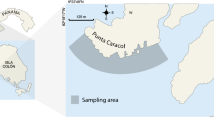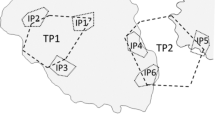Synopsis
Stegastes fasciolatus is the most common territorial damselfish in the shallow waters of Hawaii. Territorial defense was observed against other herbivorous fishes, especially acanthorids, scarids and one omnivorous chaetodontid. One acanthurid,Acanthurus nigrofuscus was found to differ in abundance and social behavior in areas whereS. fasciolatus was present, compared to areas where it was absent. The chaetodontid,Chaetodon quadrimaculatus was sheltered during the day in areas where the pomacentrid was abundant, apparently feeding at night. In other areas it fed during the day and at night, depending on the phase of the moon.S. fasciolatus were then experimentally removed from one study site, to test whether the differences in abundance and behavior of the other species were due to the presence of the damselfish. There was a significant increase in numbers of the surgeonfishAcanthurus nigrofuscus in the removal area, as well as changes in social behavior from schooling to defense of small territories. The butterflyfish,C. quadrimaculatus, was observed to forage during the day in the removal area. There were no significant changes in the control sites. The presence of the interspecifically territorial damselfish,S. fasciolatus, thus appears to be an important determinant of the behavior of these potential food competitors.
Similar content being viewed by others
References cited
Barlow, G.W. 1974. Extraspecific imposition of social grouping among surgeonfishes. J. Zool. Lond. 174: 333–340.
Brock, R.E. 1982. A critique of the visual census method for assessing coral reef fish populations. Bull. Mar. Sci. 32: 269–276.
Brock, V.E. 1954. A preliminary report on a method of estimating reef fish populations. J. Wildl. Mgmt. 18: 297–308.
Burgess, W.E. 1978. Butterflyfishes of the world. T.F.H. Publications, Neptune City. 832 pp.
Ebersole, J.P. 1977. The adaptive significance of interspecific territoriality in the reef fish:Eupomacentrus leucosticus. Ecology 58: 914–920.
Hayes, T.A., T.F. Hourigan, S.C. Jazwinski Jr., S.R. Johnson, J.D. Parrish & D.J. Walsh. 1982. The coastal resources, fisheries and fishery ecology of Puako, West Hawaii, Hawaii Coop. Fishery Research Unit Tech. Rep. 82-1
Helfrich, P.T., T. Piyakarnchana & P.S. Miles. 1968. Ciguatera fish poisoning. 1. The ecology of ciguateric reef fishes in the Line Islands. Occas. Pap Bernice P. Bishop Mus. 23: 305–369.
Hixon, M.A. 1980. Competitive interactions between California reef fishes of the GenusEmbiotoca. Ecology 61: 918–931.
Hixon, M.A. & W.N. Brostoff. 1981. Fish grazing and community structure of Hawaiian reef algae. pp. 507–514. In: Proc. 4th Int. Coral Reef Symp. 2, Manila.
Hixon, M.A. & W.N. Brostoff. 1983. Damselfish as keystone species in reverse: intermediate disturbance and diversity of reef algae. Science 220: 511–513.
Hobson, E.S. 1974. Feeding relationships of the teleostean fishes on coral reefs in Kona, Hawaii. U.S. Fish. Bull. 72: 915–1031.
Huntingford, F.A. 1984. Some ethical issues raised by studies of predation and aggression. Anim. Behav. 32: 210–215.
Itzkowitz, M. 1975. A behavioral reconnaissance of some Jamaican reef fishes. Zool. J. Linn. Soc. 55: 87–118.
Jones, R.S. 1968. Ecological relationships in Hawaiian and Johnston Island Acanthuridae (surgeonfishes). Micronesica 4: 309–361.
Larson, R.J. 1980. Competition, habitat selection, and the bathymetric segregation of two rockfish (Sebastes) species. Ecol. Monogr. 50: 221–239.
Losey, G.S. 1982. Ecological cues and experience modify the interspecific aggression by the damselfish,Stegastes fasciolatus. Behav. 81: 14–37.
Low, R.M. 1971. Interspecific territoriality in a pomacentrid reef fish,Pomacentrus flavicauda Whitley. Ecology 52: 648–654.
MacDonald, C.D. 1981. Reproductive strategies and social organization in damselfishes. Ph.D. Dissertation, University of Hawaii, Honolulu. 226 pp
Mahoney, B.M. 1981. An examination of interspecific territoriality in the dusky damselfish,Eupomacentrus dorsopunicans Poey. Bull. Mar. Sci. 31: 141–146.
Miller, R.J. 1978. Agonistic behavior in fishes and terrestrial vertebrates. pp. 281–312. In: E.S. Reese & E.J. Lighter (ed.) Contrasts in Behavior, John Wiley & Sons, New York.
Myrberg, A.A. Jr. 1972. Ethology of the bicolor damselfish,Eupomacentrus partitus (Pisces: Pomacentridae). A comparative analysis of laboratory and field behavior. Anim. Behav. Monogr. 5: 197–283.
Reese, E.S. 1964. Ethology and marine zoology. Oceonogr. Mar. Biol. Ann Rev. 2: 455–488.
Reese, E.S. 1973. Duration of residence by coral reef fishes on ‘home’ reefs. Copeia 1973: 145–149.
Reese, E.S. 1975. A comparative field study of the social behaviour and related ecology of reef fishes of the family Chaetodontidae. Z. Tierpsychol. 37–61.
Reese, E.S. 1981. Predation on corals by fishes of the family Chaetodontidae: implications for conservation and management of coral reef ecosystems. Bull. Mar Sci. 31: 594–604.
Robertson, D.R. & B. Lassig. 1980. Spatial distribution patterns and coexistence of a group of territorial damselfishes from the Great Barrier Reef. Bull Mar. Sci. 30: 187–203.
Robertson, D.R., H.P.A. Sweatman, E.A. Fletcher & M.G. Cleland. 1976. Schooling as a mechanism for circumventing the territoriality of competitors. Ecology 57: 1208–1220.
Sale, P.F. 1974. Mechanisms of co-existence in a guild of territorial fishes at Heron Island. Proc. 2nd Int. Coral Reef Symp. London 1: 193–206.
Sale, P.F. 1976. The effects of territorial adult pomacentrids on the recruitment and survival of juveniles on patches of coral rubble. J. Exp. Mar. Biol. Ecol. 24: 297–306.
Sale, P.F. 1978. Coexistence of coral reef fishes — a lottery for living space. Env. Biol. Fish. 3: 85–102.
Shaklee, J. 1984. Genetic variation and population structure in the damselfishStegastes fasciolatus, throughout the Hawaiian archipelago. Copeia 1984: 629–640.
Syrop, S.B. 1974. Three selected aspects of the territorial behavior of a pomacentrid fish,Pomacentrus jenkensi. M.S. Research Report, University of Hawaii, Honolulu
Tate, M.W. & W.C. Clelland. 1957. Nonparametric and shortcut statistics. Interstate Printing & Publ. Danville. 171 pp.
Thompson, S.M. & G.P. Jones. 1983. Interspecific territoriality and competition for food between the reef fishesForsterygion varium andPseudolabrus celidotus. Mar. Biol. 76: 95–104.
Vine, P.J. 1974. Effects of algal grazing and aggressive behavior of the fishesPomacentrus lividus andAcanthurus sohal on coral reef ecology. Mar. Biol. 24: 131–136.
Walsh, W.J. 1984. Aspects of nocturnal shelter, habitat space, and juvenile recruitment in Hawaiian coral reef fishes. Ph.D. Dissertation, University of Hawaii, Honolulu. 475 pp.
Author information
Authors and Affiliations
Rights and permissions
About this article
Cite this article
Hourigan, T.F. An experimental removal of a territorial pomacentrid: effects on the occurrence and behavior of competitors. Environ Biol Fish 15, 161–169 (1986). https://doi.org/10.1007/BF00002991
Received:
Accepted:
Published:
Issue Date:
DOI: https://doi.org/10.1007/BF00002991




